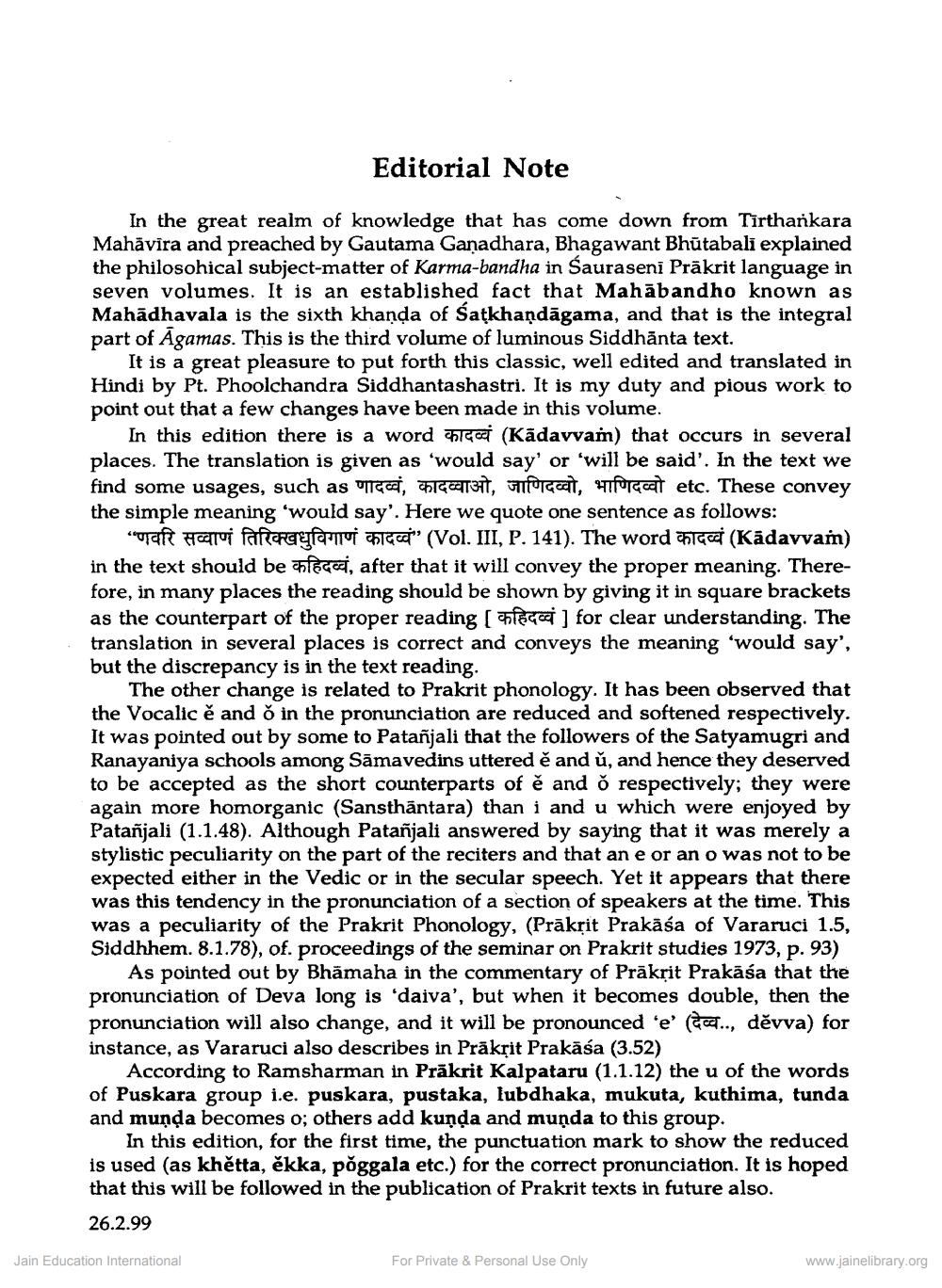Book Title: Mahabandho Part 3 Author(s): Bhutbali, Fulchandra Jain Shastri Publisher: Bharatiya Gyanpith View full book textPage 6
________________ Editorial Note In the great realm of knowledge that has come down from Tīrthankara Mahāvīra and preached by Gautama Ganadhara, Bhagawant Bhūtabali explained the philosohical subject-matter of Karma-bandha in Sauraseni Prākrit language in seven volumes. It is an established fact that Mahābandho known as Mahādhavala is the sixth khanda of Satkhandāgama, and that is the integral part of Āgamas. This is the third volume of luminous Siddhanta text. It is a great pleasure to put forth this classic, well edited and translated in Hindi by Pt. Phoolchandra Siddhantashastri. It is my duty and pious work to point out that a few changes have been made in this volume. In this edition there is a word ched (Kādavvam) that occurs in several places. The translation is given as 'would say' or 'will be said'. In the text we find some usages, such as OGCI, IGCast, Ca, forcat etc. These convey the simple meaning 'would say'. Here we quote one sentence as follows: curaft Healui faftaraf ui TG cai" (Vol. III, P. 141). The word ongedi (Kādavvarn) in the text should be chiect, after that it will convey the proper meaning. Therefore, in many places the reading should be shown by giving it in square brackets as the counterpart of the proper reading (heged] for clear understanding. The translation in several places is correct and conveys the meaning 'would say', but the discrepancy is in the text reading. The other change is related to Prakrit phonology. It has been observed that the Vocalic ě and o in the pronunciation are reduced and softened respectively. It was pointed out by some to Patañjali that the followers of the Satyamugri and Ranayaniya schools among Sāmavedins uttered ě and ů, and hence they deserved to be accepted as the short counterparts of ě and respectively; they were again more homorganic (Sansthāntara) than i and u which were enjoyed by Patañjali (1.1.48). Although Patanjali answered by saying that it was merely a stylistic peculiarity on the part of the reciters and that an e or ano was not to be expected either in the Vedic or in the secular speech. Yet it appears that there was this tendency in the pronunciation of a section of speakers at the time. This was a peculiarity of the Prakrit Phonology, (Prākrit Prakāśa of Vararuci 1.5, Siddhhem. 8.1.78), of. proceedings of the seminar on Prakrit studies 1973, p. 93) As pointed out by Bhämaha in the commentary of Prākrit Prakāśa that the pronunciation of Deva long is daiva', but when it becomes double, then the pronunciation will also change, and it will be pronounced 'e' (cel.., děvva) for instance, as Vararuci also describes in Prākrit Prakāśa (3.52) According to Ramsharman in Prākrit Kalpataru (1.1.12) the u of the words of Puskara group i.e. puskara, pustaka, lubdhaka, mukuta, kuthima, tunda and munda becomes o; others add kunda and munda to this group. In this edition, for the first time, the punctuation mark to show the reduced is used (as khětta, ěkka, põggala etc.) for the correct pronunciation. It is hoped that this will be followed in the publication of Prakrit texts in future also. 26.2.99 Jain Education International For Private & Personal Use Only www.jainelibrary.orgPage Navigation
1 ... 4 5 6 7 8 9 10 11 12 13 14 15 16 17 18 19 20 21 22 23 24 25 26 27 28 29 30 31 32 33 34 35 36 37 38 39 40 41 42 43 44 45 46 47 48 49 50 51 52 53 54 55 56 57 58 59 60 61 62 ... 510
